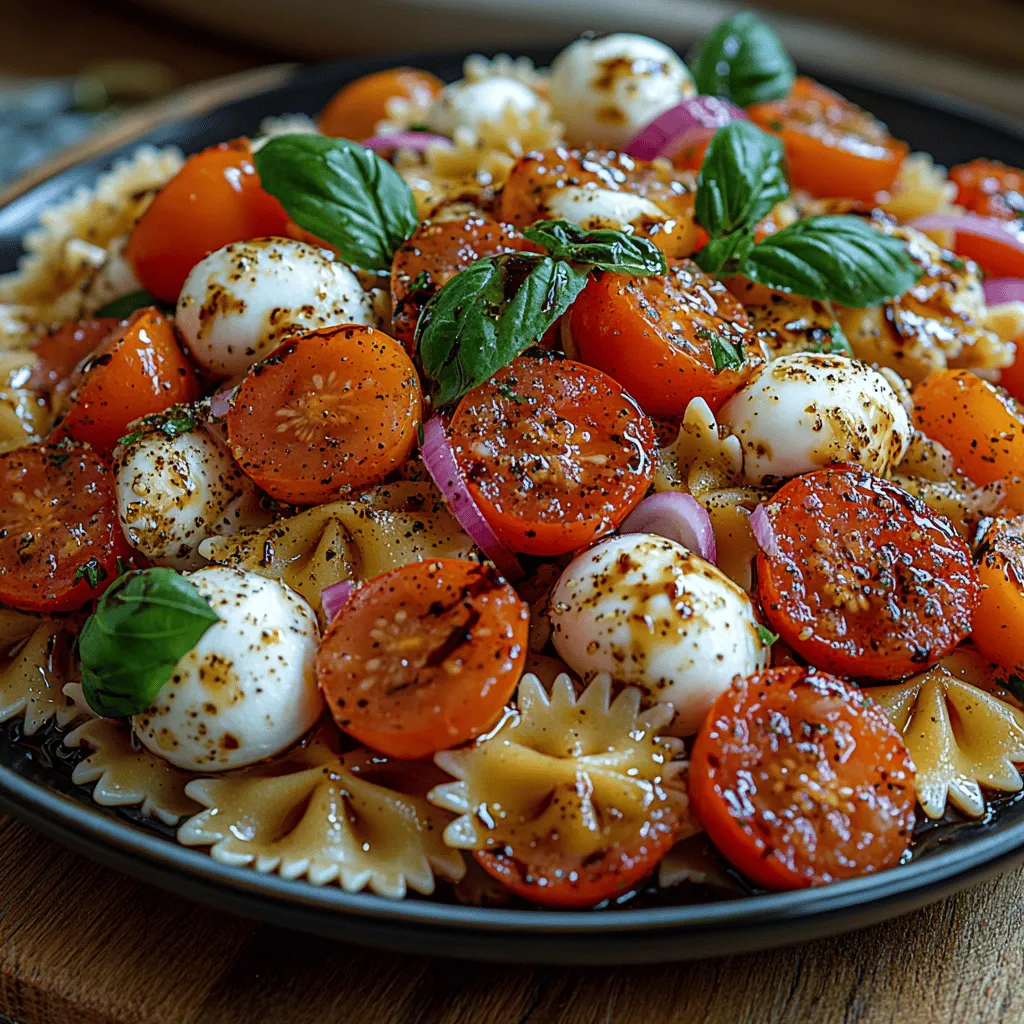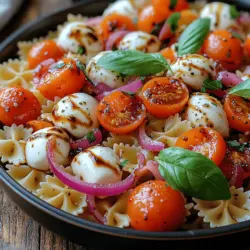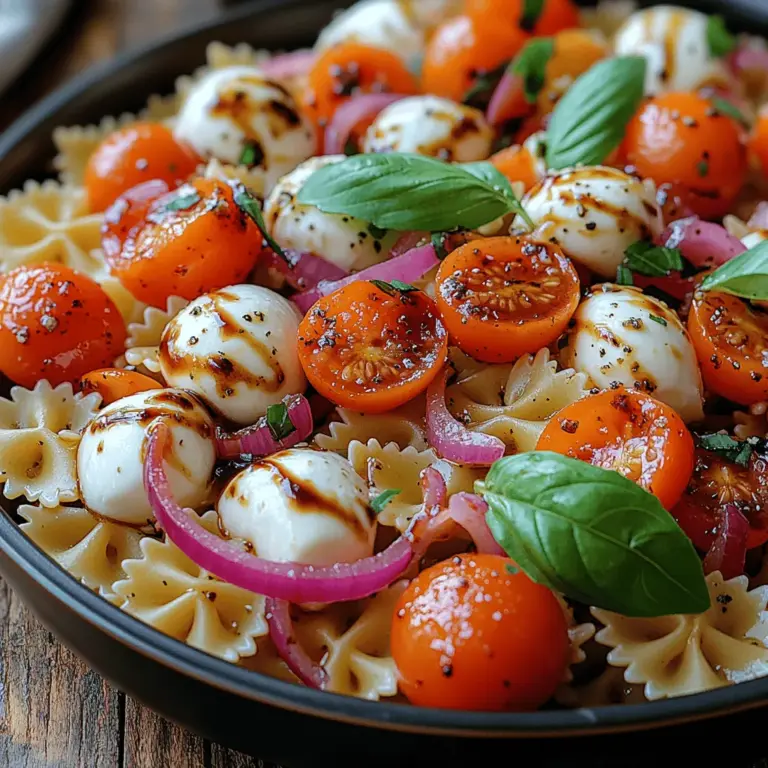Introduction
Originating from the sun-kissed shores of Italy, the Caprese salad is a celebrated dish that embodies the essence of fresh, high-quality ingredients. Traditionally composed of vibrant tomatoes, creamy mozzarella, and aromatic basil, this salad pays homage to the colors of the Italian flag while delivering a refreshing burst of flavor in every bite. Its simplicity has made it a staple in Italian cuisine, enjoyed as an appetizer or a light meal, especially during the warm summer months.
In recent years, a delightful variation has emerged: the Caprese pasta salad. This innovative twist combines the classic elements of the traditional salad with the heartiness of pasta, creating a dish that is not only visually appealing but also satisfying and versatile. Perfect for potlucks, barbecues, or even as a meal prep option, the Caprese pasta salad offers an easy way to serve a crowd while allowing for personal touches and ingredient swaps to cater to varying tastes.
What makes this dish even more enticing is its vibrant array of colors and fresh flavors. Imagine a bowl filled with al dente pasta, glistening cherry tomatoes, silky mozzarella pearls, and fragrant basil leaves, all drizzled with a rich balsamic glaze. The visual presentation alone is enough to make your mouth water, but it’s the harmony of flavors and textures that truly makes this salad a must-try for any pasta lover or health-conscious eater.
The Essence of a Caprese Pasta Salad
At the heart of the Caprese pasta salad are the classic components that define the traditional Caprese salad: ripe tomatoes, fresh mozzarella, and fragrant basil. Each ingredient plays a pivotal role in creating a dish that is both flavorful and satisfying.
Classic Components
– Tomatoes: The foundation of any great Caprese salad is the quality of the tomatoes. Ripe, juicy tomatoes provide a burst of sweetness and acidity that balances beautifully with the rich creaminess of the mozzarella. For the pasta salad, cherry tomatoes are often the preferred choice due to their small size, sweetness, and convenience; they can be halved or left whole for added texture.
– Mozzarella: Next comes the mozzarella, which adds a creamy, luxurious element to the dish. Fresh mozzarella, with its delicate texture and mild flavor, is ideal for this salad. It can be found in various forms, including mozzarella balls (bocconcini) and larger blocks. The key is to select high-quality cheese, as the flavor and texture can significantly impact the overall experience of the salad.
– Basil: Fresh basil is the aromatic star of this dish, providing a fragrant and slightly peppery flavor that complements the other ingredients perfectly. In addition to its culinary appeal, basil is known for its health benefits, including anti-inflammatory properties and a rich source of antioxidants.
Importance of Freshness
The success of a Caprese pasta salad is heavily reliant on the freshness of its ingredients. When using fresh, high-quality components, you elevate the dish from a simple salad to a gourmet experience. Each bite should burst with flavor, and using seasonal produce ensures that you achieve the best taste possible.
Role of Pasta
While the traditional Caprese salad relies solely on the classic trio of ingredients, adding pasta transforms it into a hearty main or side dish. The pasta serves as a filling base that enhances the texture and makes the salad more substantial. Opting for pasta shapes that have ridges or crevices, like bowtie or fusilli, allows the dressing to cling to each piece, ensuring that every mouthful is packed with flavor.
Ingredients Breakdown
Creating the perfect Bright and Bubbly Caprese Pasta Salad with Balsamic Glaze starts with selecting the best ingredients. Here’s a detailed breakdown of what you’ll need to achieve this vibrant dish:
Pasta: Choosing the Right Type
The pasta you choose can significantly impact the texture and overall feel of your salad. For this Caprese pasta salad, two popular options are bowtie (farfalle) and fusilli. Bowtie pasta adds a fun, playful shape that holds onto the dressing well, while fusilli’s spiral shape creates a delightful mouthfeel, ensnaring bits of cheese and tomato with each forkful. Aim for high-quality, whole-grain or gluten-free pasta if you prefer a healthier or dietary-specific option.
Cherry Tomatoes: Benefits of Using Fresh Tomatoes
When it comes to tomatoes, fresh is always best. Cherry tomatoes are an excellent choice for this recipe due to their natural sweetness and juiciness. They come in various colors, including red, yellow, and orange, allowing you to create a visually stunning salad. Their bite-sized nature means they are easy to eat and can be tossed into the salad whole or halved for added surface area to soak up the dressing.
Fresh Mozzarella: Importance of Quality and Texture
Selecting the right mozzarella is crucial for achieving the creamy texture that complements the rest of the salad. Fresh mozzarella, often sold in brine or vacuum-sealed packs, offers a soft, delicate texture that’s essential for a Caprese salad. Look for mozzarella labeled as “buffalo” for a richer flavor profile, or opt for standard cow’s milk mozzarella if that’s what you have on hand. Avoid pre-shredded mozzarella, as it often contains anti-caking agents that can alter the texture.
Fresh Basil: The Aromatic Qualities and Health Benefits
Fresh basil is a key ingredient that infuses the salad with an aromatic quality that elevates the entire dish. When selecting basil, look for vibrant green leaves that are free of blemishes. The aromatic oils in basil not only enhance the flavor but also provide health benefits, including anti-inflammatory properties and essential vitamins. To release the full flavor, tear the basil leaves just before adding them to the salad, as this helps to release their essential oils.
Red Onion: Adding Crunch and Sweetness
Incorporating red onion into your Caprese pasta salad brings an additional layer of flavor and crunch. The slight sweetness of red onions contrasts beautifully with the acidity of the tomatoes and the creaminess of the mozzarella. To mellow their sharpness, consider soaking the sliced onions in cold water for about 10 minutes before adding them to the salad. This simple trick enhances their sweetness while reducing their pungency.
Olive Oil and Balsamic Vinegar: Health Benefits and Flavor Enhancement
The dressing is a crucial component of this Caprese pasta salad, and the combination of high-quality olive oil and balsamic vinegar is a match made in culinary heaven. Olive oil is rich in healthy fats and antioxidants, making it a staple in Mediterranean diets. It adds a luxurious mouthfeel and enhances the flavors of the other ingredients. Balsamic vinegar, with its sweet-tart flavor, adds depth and complexity. Together, they create a harmonious dressing that ties the whole dish together.
Balsamic Glaze: Store-Bought vs. Homemade Options
To elevate your Caprese pasta salad, a drizzle of balsamic glaze is the finishing touch that brings everything together. Balsamic glaze is essentially reduced balsamic vinegar, resulting in a thicker, syrupy consistency that adds a burst of flavor. You can find store-bought options in most grocery stores, but making your own is incredibly simple and allows you to control the sweetness and thickness. To make balsamic glaze at home, simmer balsamic vinegar over low heat until it reduces by half and thickens to a syrup-like consistency. This homemade version can be stored in the refrigerator and used in various recipes.
In summary, the Bright and Bubbly Caprese Pasta Salad with Balsamic Glaze is a delightful twist on a classic Italian dish that is perfect for any occasion. With its emphasis on fresh, high-quality ingredients, this salad is not only visually stunning but also packed with flavor and nutrition. The combination of pasta, tomatoes, mozzarella, basil, and a sweet balsamic glaze makes this dish a standout choice for gatherings, meal prep, or a simple weeknight dinner.
Stay tuned for the next part of the article, where we will delve into the detailed step-by-step instructions for preparing this vibrant salad, along with tips for achieving the best results possible.

Optional Ingredients: The Role of Garlic in Caprese Pasta Salad
While the core ingredients of Caprese Pasta Salad shine on their own, adding minced garlic can introduce a delightful depth of flavor. Garlic offers a pungent, aromatic quality that enhances the overall experience of the salad. When used in moderation, it can complement the freshness of the tomatoes and basil without overpowering them. Consider using roasted garlic for a milder, sweeter taste or fresh garlic for a more pronounced kick. The choice to include garlic ultimately depends on your personal preference and the desired flavor profile of your dish.
Step-by-Step Instructions
Cooking the Pasta: Tips for Achieving the Perfect Al Dente Texture
1. Choose the Right Pasta: For Caprese Pasta Salad, short pasta shapes such as fusilli, penne, or farfalle work best. These shapes hold onto the dressing and other ingredients well.
2. Boil Water: Fill a large pot with water and add a generous amount of salt. The water should taste like the sea. Bring it to a rolling boil.
3. Add the Pasta: Once the water is boiling, add the pasta and stir immediately to prevent sticking. Cook according to the package instructions, usually around 8-12 minutes for al dente.
4. Test for Doneness: About a minute before the suggested cooking time is up, taste a piece of pasta. It should be firm to the bite but cooked through.
5. Drain and Rinse: Once the pasta is cooked, drain it in a colander. Rinse with cold water to stop the cooking process and cool the pasta down, which will prevent it from becoming mushy.
Preparing the Vegetables: Techniques for Slicing and Mixing for Optimal Flavor Distribution
1. Tomatoes: Use ripe, juicy tomatoes for the best flavor. Cut them into bite-sized pieces, ensuring that the juices are retained. This will add moisture to the salad.
2. Mozzarella: If using fresh mozzarella balls (bocconcini), simply halve them. For larger mozzarella blocks, cut into small cubes. The creamy texture will balance well with the acidity of the tomatoes.
3. Basil: Wash the basil leaves and pat them dry. Stack several leaves, roll them tightly, and slice thinly (a technique known as chiffonade) to release their aromatic oils.
4. Mixing: Gently combine the vegetables in a large bowl, being careful not to crush the tomatoes or mozzarella. This ensures even distribution of flavors throughout the dish.
Whisking the Dressing: Importance of Emulsifying the Oil and Vinegar for a Cohesive Taste
1. Measure Ingredients: In a small bowl, combine extra virgin olive oil and balsamic vinegar in a ratio of about 3:1. Add salt and pepper to taste, along with any optional ingredients like minced garlic.
2. Whisk Vigorously: Use a whisk or fork to vigorously mix the ingredients together. This process helps emulsify the oil and vinegar, creating a cohesive dressing that adheres to the pasta and vegetables.
3. Taste and Adjust: After whisking, taste the dressing. You may want to adjust the seasoning or acidity level by adding more vinegar or a pinch of sugar to balance the flavors.
Combining Ingredients: Best Practices for Folding in Ingredients to Maintain Texture
1. Combine Pasta and Vegetables: In a large mixing bowl, add the cooled pasta to the vegetables. This is where the magic happens; be gentle to avoid breaking the pasta or the delicate mozzarella.
2. Drizzle the Dressing: Pour the freshly whisked dressing over the pasta and vegetables. Start with a small amount, and you can always add more if needed.
3. Fold, Don’t Stir: Use a spatula or large spoon to gently fold the ingredients together, ensuring even coating without crushing the components. This method helps maintain the integrity of the pasta and mozzarella.
Final Touches: The Significance of the Balsamic Glaze Drizzle for Presentation and Flavor
1. Drizzle the Glaze: For an elegant finish, drizzle balsamic glaze over the top of the salad just before serving. This not only enhances the flavor but also adds a beautiful presentation element.
2. Garnish with Basil: Sprinkle fresh basil leaves on top for a pop of color and an extra burst of flavor. This enhances the visual appeal and invites guests to dig in.
3. Serve Immediately or Chill: You can serve the Caprese Pasta Salad immediately for a fresh taste or refrigerate it for 30 minutes to allow the flavors to meld. If chilling, consider adding a touch more dressing before serving, as pasta can absorb it over time.
Serving Suggestions
Caprese Pasta Salad is incredibly versatile and perfect for a variety of occasions. Here are some ideal serving suggestions:
– Occasions: This salad is a fantastic option for picnics, barbecues, and potlucks. Its vibrant colors and fresh flavors make it a crowd-pleaser, and it can be made ahead of time, freeing you up to enjoy the event.
– Pairing with Other Dishes: Caprese Pasta Salad pairs well with grilled meats like chicken, steak, or shrimp. The lightness of the salad complements hearty dishes, making it an excellent side. Additionally, serving it with crusty bread can create a satisfying meal that balances textures and flavors.
– Presentation Ideas: For an impressive presentation, serve the salad in a large, decorative bowl. Alternatively, individual portions in mason jars or small bowls can add a charming touch to gatherings. Garnishing with extra basil or cherry tomatoes can elevate the visual appeal further.
Nutritional Information
Caprese Pasta Salad is not only delicious but also offers a range of nutritional benefits:
– Overview of Nutritional Benefits: This salad is rich in vitamins and minerals from fresh vegetables, healthy fats from olive oil, and protein from mozzarella. Tomatoes are packed with antioxidants, while basil provides anti-inflammatory properties.
– Dietary Considerations: The base recipe is vegetarian and can be made gluten-free by using gluten-free pasta. To make it vegan, substitute mozzarella with a plant-based cheese alternative. This adaptability allows it to cater to various dietary needs.
– Balancing Within a Healthy Diet: While Caprese Pasta Salad is nutritious, portion sizes are essential to consider. A serving of about one to one-and-a-half cups makes for a balanced side dish or a light main course, particularly when paired with protein-rich foods.
Conclusion
The simplicity and satisfaction of making Caprese Pasta Salad cannot be overstated. With its fresh ingredients, vibrant colors, and delightful flavors, this dish is perfect for any occasion. Its versatility allows for adaptations based on personal preferences, making it suitable for various palates.
Encouraging experimentation with ingredient variations, such as adding roasted vegetables or different cheeses, can lead to exciting new interpretations of this classic recipe. The Caprese Pasta Salad is not just a dish; it’s a canvas for culinary creativity. So, gather your ingredients, embrace the process, and enjoy the bright, bubbly flavors that celebrate the essence of summer in every bite.


